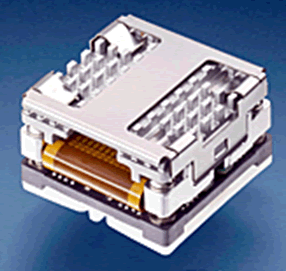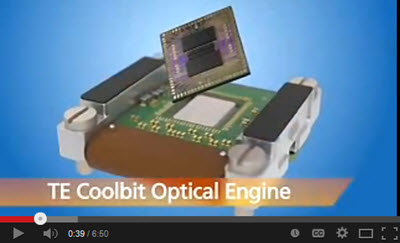Q&A: TE on the Future of Optical Technology
After two years of incubation and development, TE Connectivity (TE) unveiled the company’s latest advancement in fiber optics: Coolbit optical engines. TE’s Nathan Tracy answered our questions about the future of optical technology.
 CS: Rather than build an optical engine using off-the-shelf components, TE chose to differentiate its products by focusing the design on the two critical performance requirements of bandwidth density and low power consumption.Why NOT build an optical engine with off-the-shelf components?
CS: Rather than build an optical engine using off-the-shelf components, TE chose to differentiate its products by focusing the design on the two critical performance requirements of bandwidth density and low power consumption.Why NOT build an optical engine with off-the-shelf components?
NT: TE knew that the industry was grappling with power consumption issues, so from the inception of the Coolbit project the team was focused on doing whatever was required to develop a low-power solution. Using a highly integrated custom IC approach was critical to meeting that objective.
CS: How will Coolbit change fiber optics? How will its launch affect the market as well as future applications in this area?
NT: The launch of Coolbit will change the paradigm of acceptable optical transceiver power consumption. The market will continue to require ever more challenging performance levels and TE will continue its relentless efforts to bring engineering innovation to meet those needs.
CS: What’s next? Where do you see this technology, the market, and these applications going in the next five or 10 years?
NT: The market will continue to provide challenging requirements as the demand for cost-effective, higher-bandwidth optical links continues to grow. Reduced power consumption is only one of the requirements, as we expect the trend of higher levels of integration to continue to move optics “inside the box” and drive a need for higher data rates in smaller packages. TE will not rest with the Coolbit development; we will continue to deliver innovative performance in new packaging styles.
CS: Why was TE the supplier that was able to do this?
TE innovates like a startup company, always looking for new ways to solve problems. With the resources of a $13.3 billion company, fully committed to meeting our customer’s evolving requirements, our engineering team took a fresh look at how to realize the optical transceiver expectations and decided we could deliver better performance by attacking the power consumption challenge with higher levels of integration. Throughout the development phase, this focus on power did not let up; it remained a key objective for us. In addition, our ability to fully control all aspects of the product development in our fully integrated engineering and production facility meant that we did not have to rely on others, we had control of our destiny.
To see how Coolbit optical engines are built, take a video tour of TE’s fabrication facility in Jarfalla, Sweden.
[hr]
 Nathan Tracy is currently a technologist on TE’s data communications systems architecture team. He also serves as manager of industry standards, playing an active role in IEEE 802.3 standards and the Optical Internetworking Forum (OIF), where he serves as the technical committee chairman. Nathan is also chairman of the recently announced CDFP MSA, leading the development of the industry’s first 400Gb/s form factor.
Nathan Tracy is currently a technologist on TE’s data communications systems architecture team. He also serves as manager of industry standards, playing an active role in IEEE 802.3 standards and the Optical Internetworking Forum (OIF), where he serves as the technical committee chairman. Nathan is also chairman of the recently announced CDFP MSA, leading the development of the industry’s first 400Gb/s form factor.








